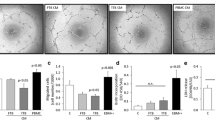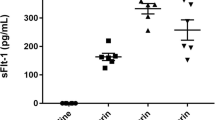Abstract
Vascular Endothelial Growth Factor Receptor (VEGFR) mediated signalling drives angiogenesis. This is predominantly attributed to the activity of VEGFR-2 following binding of VEGF-A. Whether other members of the VEGFR and ligand families such as VEGFR-1 and its ligand Placental Growth Factor (PlGF) can also contribute to developmental and pathological angiogenesis is less clear. We explored the function of PlGF in VEGF-A dependent angiogenesis using an in vitro co-culture assay in which endothelial cells are cultured on a fibroblast feeder layer. In the presence of 2% FS MCDB media (containing limited growth factors) in vitro endothelial tube formation is driven by endogenous angiogenic stimuli which are produced by the fibroblast and endothelial cells. Under these conditions independent sequestration of either free VEGF-A or PlGF with polyclonal and monoclonal antibodies inhibited tube formation suggesting that both ligands are required to drive an angiogenic response. Endothelial tube formation could only be driven within this assay by the addition of exogenous VEGF-A, VEGF-E or VEGF-A/PlGF heterodimer, but not by PlGF alone, implying that activation of either VEGFR-2/VEGFR-1 heterodimers or VEGFR-2 homodimers were responsible for eliciting an angiogenic response directly, but not VEGFR-1 homodimers. In contrast to results obtained with an endogenous angiogenic drive, sequestration of PlGF did not affect endothelial tube formation when the assay was driven by 1 ng/ml exogenous VEGF-A. These data suggest that although neutralising PlGF can be shown to reduce endothelial tube formation in vitro, this effect is only observed under restricted culture conditions and is influenced by VEGF-A. Such data questions whether neutralising PlGF would have a therapeutic benefit in vivo in the presence of pathological concentrations of VEGF-A.




Similar content being viewed by others
References
Carmeliet P (2003) Angiogenesis in health and disease. Nat Med 9(6):653–660
Ferrara N, Kerbel RS (2005) Angiogenesis as a therapeutic target. Nature 438:967–974
Ferrara N (2002) Role of vascular endothelial growth factors in physiologic and pathologic angiogenesis. Semin Oncol 29:10–14
Olsson AK, Dimberg A, Kreuger J, Claesson-Welsh L (2006) VEGF receptor signalling–in control of vascular function. Nat Rev Mol Cell Biol 7:359–371
Petrova T, Makinen T, Alitalo K (1999) Signalling via vascular endothelial growth factor receptors. Exp Cell Res 253:117–130
Matsumoto T, Claesson-Welsh L (2001) VEGF receptor signal transduction. Sci STKE 112:RE21
DiSalvo J, Bayne ML, Conn G, Kwok PW, Trivedi PG, Soderman DD, Palisi TM, Sullivan KA, Thomas KA (1995) Purification and characterization of a naturally occurring vascular endothelial growth factor. Placenta growth factor heterodimer. J Biol Chem 270:7717–7723
Cao Y, Chen H, Zhou L, Chiang MK, Anand-Apte B, Weatherbee JA, Wang Y, Fang F, Flanagan JG, L-S TsangM (1996) Heterodimers of placenta growth factor/vascular endothelial growth factor. J Biol Chem 271:3154–3162
Nagy JA, Dvorak AM, Dvorak HF (2003) VEGF-A164/165 and PlGF roles in angiogenesis and arteriogenesis. Trends Cardiovasc Med 13:169–175
Fong GH, Rossant J, Gertsenstein M, Breitman ML (1995) Role of the Flt-1 receptor tyrosine kinase in regulating the assembly of vascular endothelium. Nature 376:66–70
Hiratsuka S, Minowa O, Kuno J, Noda T, Shibuya M (1998) Flt-1 lacking the tyrosine kinase domain is sufficient for normal development and angiogenesis in mice. Proc Natl Acad Sci USA 95:9349–9354
Luttun A, Tjwa M, Moons L, Wu Y, Angelillo-Scherrer A, Liao F, Nagy JA, Hooper A, Priller J, De Klerck B, Compernolle V, Daci E, Bohlen P, Dewerchin M, Herbert JM, Fava R, Matthys P, Carmeliet G, Collen D, Dvorak HF, Hicklin DJ, Carmeliet P (2002) Revascularization of ischemic tissues by PlGF treatment, and inhibition of tumor angiogenesis, arthritis and atherosclerosis by anti-Flt1. Nat Med 8:831–840
Wang ES, Teruya-Feldstein J, Wu Y, Zhu Z, Hicklin DJ, Moore MAS (2004) Targeting autocrine and paracrine VEGF receptor pathways inhibits human lymphoma xenografts in vivo. Blood 10:2893–2902
Nishi J, Minamino T, Hideyuki M, Nojima A, Tateno K, Okada S, Orimo M, Moriya J, Fong G, Sunagawa K, Shibuya M, Komuro I (2008) Vascular endothelial growth factor receptor-1 regulates postnatal angiogenesis through inhibition of the excessive activation of Akt. Circ Res 103:261–268
Tchaikovski V, Fellbrich G, Waltenberger J (2008) The molecular basis of VEGFR-1 signal transduction pathways in primary human monocytes. Arterioscler Thromb Vasc Biol 28(2):322–328
Murakami M, Zheng Y, Hirashima M, Suda T, Morita Y, Ooehara J, Ema H, Fong GH, Shibuya M (2008) VEGFR-1 tyrosine kinase signaling promotes lymphangiogenesis as well as angiogenesis indirectly via macrophage recruitment. Arterioscler Thromb Vasc Biol 28(4):658–664
Murakami M, Iwai S, Hiratsuka S, Yamauchi M, Nakamura K, Iwakura Y, Shibuya M (2006) Signaling of vascular endothelial growth factor receptor-1 tyrosine kinase promotes rheumatoid arthritis through activation of monocytes/macrophages. Blood 108(6):1849–1856
Carmeliet P, Moons L, Luttun A, Vincenti V, Compernolle V, De Mol M, Wu Y, Bono F, Devy L, Beck H, Scholz D, Acker T, DiPalma T, Dewerchin M, Noel A, Stalmans I, Barra A, Blacher S, Vandendriessche T, Ponten A, Eriksson U, Plate KH, Foidart JM, Schaper W, Charnock-Jones DS, Hicklin DJ, Herbert JM, Collen D, Persico MG (2001) Synergism between vascular endothelial growth factor and placental growth factor contributes to angiogenesis and plasma extravasation in pathological conditions. Nat Med 7:575–583
Cianfarani F, Zambruno LB, Sera F, Lacal PM, Pesce M, Capogrossi MC, Failla CM, Napolitano M, Odrisio T (2006) Placenta growth factor in diabetic wound healing. Am J Pathol 169:1167–1182
Adini A, Kornag T, Firoozbakht F, Benjamin LE (2002) Placental growth factor is a survival factor for tumor endothelial cells and macrophages. Cancer Res 62:2749–2752
Fischer C, Jonckx B, Mazzone M, Zacchigna S, Loges S, Pattarini L, Chorianopoulos E, Liesenborghs L, Koch M, De Mol M, Autiero M, Wyns S, Plaisance S, Moons L, van Rooijen N, Giacca M, Stassen JM, Dewerchin M, Collen D, Carmeliet P (2007) Anti-PlGF inhibits growth of VEGF(R)-inhibitor-resistant tumors without affecting healthy vessels. Cell 131(3):463–475
Kappas NC, Zeng G, Chappell JC, Kearney JB, Hazarika S, Kallianos KG, Patterson C, Annex BH, Bautch VL (2008) The VEGF receptor Flt-1 spatially modulates Flk-1 signaling and blood vessel branching. J Cell Biol 181(5):847–858
Autiero M, Waltenberger J, Communi D, Kranz A, Moons L, Lambrechts D, Kroll J, Plaisance S, De Mol M, Bono F, Kliche S, Fellbrich G, Ballmer-Hofer K, Maglione D, Mayr-Beyrle U, Dewerchin M, Dombrowski S, Stanimirovic D, Van Hummelen P, Dehio C, Hicklin DJ, Persico G, Herbert JM, Communi D, Shibuya M, Collen D, Conway EM, Carmeliet P (2003) Role of PlGF in the intra- and intermolecular cross talk between the VEGF receptors Flt1 and Flk1. Nat Med 9:936–942
Brave SR, Bigley A, Kendrew J, Cornforth S, Wedge SR (2002) Characterisation and quantification of an endothelial cell tube formation assay. Br J Cancer 86(Suppl 1):S34–S121
Wedge SR, Kendrew J, Hennequin LF et al (2005) AZD2171: a highly potent, orally bioavailable, vascular endothelial growth factor receptor-2 tyrosine kinase inhibitor for the treatment of cancer. Cancer Res 65:4389–4400
Ishizaki H, Tsunoda T, Wada S, Yamauchi M, Shibuya M, Tahara H (2006) Inhibition of tumor growth with antiangiogenic cancer vaccine using epitope peptides derived from human vascular endothelial growth factor receptor 1. Clin Cancer Res 12:5841–5849
Bishop ET, Bell GT, Bloor S, Broom IJ, Hendry NFK, Wheatley DN (1999) An in vitro model of angiogenesis: basic features. Angiogenesis 3:335–344
Donovan D, Brown NJ, Bishop ET, Lewis CE (2001) Comparison of three in vitro human ‘angiogenesis’ assays with capillaries formed in vivo. Angiogenesis 4:113–121
Mavria G, Vercoulen Y, Yeo M, Paterson H, Karasarides M, Marais R, Bird D, Marshall CJ (2006) ERK-MAPK signaling opposes Rho-kinase to promote endothelial cell survival and sprouting during angiogenesis. Cancer Cell 9:33–44
Jones MC, Caswell PT, Moran-Jones K, Roberts M, Barry ST, Gampbel A, Mellor H, Norman JC (2009) VEGFR-1 (Flt1) regulates RAb4 recycling to control fibronectin polymerisation and endothelial cell branching. Traffic 10:753–766
Kendrew et al (2010) manuscript in preparation
Zhao B, Cai J, Boulton M (2004) Expression of placenta growth factor is regulated by both VEGF and hyperglycaemia via VEGFR-2. Microvasc Res 68:239–246
Yao YG, Yang HS, Cao Z, Danielsson J, Duh EJ (2005) Upregulation of placenta growth factor by vascular endothelial growth factor via a post-transcriptional mechanism. FEBS Lett 579:1227–1234
Bussolati B, Dunk C, Grohman M, Kontos CD, Mason J, Ahmed A (2001) Vascular endothelial growth factor receptor-1 modulates vascular endothelial growth factor mediated angiogenesis via nitric oxide. Am J Pathol 159:993–1008
Cai J, Ahmad S, Jiang WG, Huang J, Kontos CD, Boulton M, Ahmed A (2003) Activation of vascular endothelial growth factor receptor-1 sustains angiogenesis and Bcl-2 expression via the phosphatidylinositol 3-kinase pathway in endothelial cells. Diabetes 52:2959–2968
Kanno S, Oda N, Abe M, Terai Y, Ito M, Shitara K, Tabayashi K, Shibuya M, Sato Y (2000) Roles of two VEGF receptors, Flt-1 and KDR, in the signal transduction of VEGF effects in human vascular endothelial cells. Oncogene 19:2138–2146
Roberts DM, Kearney JB, Johnson JH, Rosenberg MP, Kumar R, Bautch VL (2004) The vascular endothelial growth factor (VEGF) receptor Flt-1 (VEGFR-1) modulates Flk-1 (VEGFR-2) signaling during blood vessel formation. Am J Pathol 164:1531–1535
Xu L, Jain R (2007) Down-regulation of placenta growth factor by promoter hypermethylation in human lung and colon carcinoma. Mol Cancer Res 5:873–880
Parr C, Watkins G, Boulton M, Cai J, Jiang WG (2005) Placenta growth factor is over-expressed and has prognostic value in human breast cancer. Eur J Cancer 41:2819–2827
Wei S-C, Tsao PN, Yu SC, Shun CT, Tsai-Wu JJ, Wu CHH, Su YN, Hsieh FJ, Wong JM (2007) Placenta growth factor expression is correlated with survival of patients with colorectal cancer. Gut 54:666–672
Ho MC, Chen CN, Lee H, Hsieh FJ, Shun CT, Chang CL, Lai YT, Lee PH (2007) Placenta growth factor not vascular endothelial growth factor A or C can predict the early recurrence after radical resection of hepatocellular carcinoma. Cancer Lett 250:237–249
Seaman S, Stevens J, Yang MY, Logsdon D, Graff-Cherry C, St. Croix B (2007) Genes that distinguish physiological and pathological angiogenesis. Cancer Cell 11:539–554
Hedlund EM, Hosaka K, Zhong A, Cao R, Cao Y (2009) Malignant cell-derived PlGF promotes normalization and remodeling of the tumor vasculature. Proc Natl Acad Sci USA 106:17505–17510
Xu L, Cochran DM, Tong RT, Winker F, Kashiwagi S, Jain RK, Fukumura D (2006) Placenta growth factor overexpression inhibits tumor growth, angiogenesis, and metastasis by depleting vascular endothelial growth factor homodimers in orthotopic mouse models. Cancer Res 66:3971–3977
Eriksson A, Cao R, Pawliuk R, Berg SM, Tsang M, Zhou D, Fleet C, Tritsaris K, Dissing S, Leboulch P, Cao Y (2002) Placenta growth factor-1 antagonizes VEGF-induced angiogenesis and tumor growth by the formation of functionally inactive PlGF-1/VEGF heterodimers. Cancer Cell 1:99–108
Bais C, Wu X, Yao J, Yang S, Crawford Y, McCutcheon K, Tan C, Kolumam G, Vernes J-M, Eastham-Anderson J, Haughney P, Kowanetz M, Hagenbeek T, Kasman I, Reslan B, Ross J, Van Bruggen N, Carano R, Meng Y, Hongo J-A, Stephan J-P, Shibuya M, Ferrara N (2010) PlGF blockade does not inhibit angiogenesis during primary tumor growth. Cell 141:166–177
Van de Veire S, Stalmans I, Heindryckx F, Oura H, Tijeras-Raballand A, Schmidt T, Loges S, Albrecht I, Jonckx B, Vinckier S, Van Steenkiste C, Tugues S, Rolny C, De Mol M, Dettori D, Hainaud P, Coenegrachts L, Contreres J-O, Van Bergen T et al (2010) Further pharmacological and genetic evidence for the efficacy of PlGF inhibition in cancer and eye disease. Cell 141:178–190
Acknowlegdments
We thank Mai Yamauchi and Sachiko Yamaguchi for the establishment of AG1-G1-Flt1 cell line. We should also like to thank Neil James for generating the AG1-G1-Flt-1 MSD data and Elizabeth Mouchet for technical assistance in using the ArrayScan.
Author information
Authors and Affiliations
Corresponding author
Rights and permissions
About this article
Cite this article
Brave, S.R., Eberlein, C., Shibuya, M. et al. Placental growth factor neutralising antibodies give limited anti-angiogenic effects in an in vitro organotypic angiogenesis model. Angiogenesis 13, 337–347 (2010). https://doi.org/10.1007/s10456-010-9190-0
Received:
Accepted:
Published:
Issue Date:
DOI: https://doi.org/10.1007/s10456-010-9190-0




